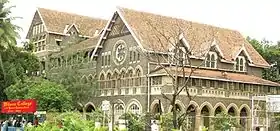Girgaon
Girgaon, formerly Girgaum, is an area in southern Mumbai in Maharashtra, India. Girgaon occupies prime residential real estate because of its prominent location in South Mumbai.
Girgaon
Girgaum | |
|---|---|
Neighbourhood | |
 Girgaon back road, c. 1905 | |
 Girgaon | |
| Coordinates: 18.953°N 72.813°E | |
| Country | India |
| State | Maharashtra |
| District | Mumbai City |
| City | Mumbai |
| Government | |
| • Type | Municipal Corporation |
| • Body | Brihanmumbai Municipal Corporation (MCGM) |
| Elevation | 12 m (39 ft) |
| Demonym(s) | Girgaonkar |
| Languages | |
| • Official | Marathi |
| Time zone | UTC+5:30 (IST) |
| PIN | 400004 |
The culture in Girgaon is diverse and varied. Like most areas of cosmopolitan Mumbai, residents span diverse languages, religions, traditions, festivals and attire.
Etymology
The name "Girgaon" is derived from the Sanskrit words "giri" and "grama". The term "gir" (from "giri") stands for hills, and "gaon" (from "grama") denotes a village. Thus, Girgaon means a village at the foothill of mountains.[1]
History
Khetwadi, ,a sparse population living off agriculture and plantations, developed in the mid-19th century with the widening of Parel road and the Girgaon road (then called the Breach Candy Road). In 1839, Grant Road was completed, leading to large-scale migration into this area. Girgaon got its own station much later at Charni Road which was opened in the year 1867. Today it has become a hub for diamond traders and wholesalers of almost all the traditional businesses.
There are a large number of temples in this area. The most well known is Thakurdwar, built by the ascetic Atmaram Baba, who died in 1838. The Kalbadevi temple, dedicated to Kali, was moved to its present site from its original location in Mahim during the rule of the Gujrati sultans. The Dadi Seth Agiary was built in 1783, the Hormusji Wadia Fire temple in 1839.
Areas


Girgaon is a prominent cultural neighbourhood for Marathi people in Mumbai. Each area of Girgaon follows its own customs. Communities like the Marathi-speakers, Gujarati, Konkani, Jains, Marwaris, Christians and Hindus follow their own customs and rituals. They celebrate different festivals, follow different customs for birth, marriage, death and other important events. Therefore, while it is easy to sense that Girgaon is different from other societies, it is very difficult to define conclusively what is essentially Girgaon or to see how such a diversity of peoples and cultures can be related to one another.
This is also the area in which Ganesh Chaturthi is celebrated in great style. The area is filled with crowds when the Ganesh Visarjan is carried out. It is not only about Ganesh Chaturthi. Girgaon also celebrates other festivals with equal zest whether Diwali, Gokulashtami or Makar Sankranti.
Girgaon is further subdivided in small neighborhoods locally called as 'wadis'. There are many such wadis in Girgaon namely - Vaidyawadi (Annapurna wadi) Bhatwadi, Jitekar wadi, Gaiwadi, Kandewadi, Bhutachi wadi, Urankar wadi, Fanas waadi, Pimpal wadi etc. One of these- Khotachi wadi is very famous for its Portuguese style wooden architecture. It is mainly inhabited by Catholics and Maharashtrian Hindus. These houses are now largely being pulled down to make way for sky scrapers and now number less than half of what it was originally. Nevertheless, foreign tourists still throng these narrow lanes of Khotachi wadi as it is one of the very few heritage villages remaining within South Mumbai. Heritage walks are often conducted here by locals and history lovers.
Largely, Girgaon also includes the outer areas around it, like Sikka Nagar, some parts of Khetwadi, Prarthana Samaj, Opera House, C.P. tank, areas around Charni Road station and Girgaon Chowpatty.
Thakurdwar area in Girgaon is also home to the India tower - the proposed highest building in India. Girgaon has a sizable Parsi population and their religious structures known as Agyaries and Atash Behrams are dotted in and around Girgaon. Large parts in Girgaon are also under the Muslim and Christian graveyards and Hindu crematorium near Charni Road station and S.K. Patil Udyan popularly known as Japanese garden. Along Khetwadi is also the biggest metal and stainless steel market in India.
Festivals
Ganeshotsav is one of the most livingly celebrated Festival in Girgaon. Ganesh Idols like Girgaoncha Maharaja, Girgaocha Raja, are well known for being Ganeshotsav Mandals (Lord Ganesh festival local Group). Despite of various mandals here in Girgaum, there's a historic place of Keshavji Nayak Chawl where Lokmanya Tilak visited Ganesh mandal in 1901 it will complete its 128 years of celebration this year (2020), also there is Jitekarwadi Famous for there idols made using unusual materials like soil and fiber, that includes idols made of dry fruits, marbles and rice.
Mumbai's Top six oldest Ganpati and Ganeshotsav Mandal are in Girgaon.
1. Keshavji Naik Chawl's ganpati is the first Ganpati and Ganeshotsav mandal of Mumbai, Keshavji Naik Chawl Sarvajanik Ganeshotsav mandal was established in 1893 to bring equality amongst people and fight against Britishers for freedom.
2. Jitekarwadi's Ganpati is the second Ganpati of Mumbai, Jitekarwadi Sarvajanik Ganeshotsav mandal was established in 1894. Then Ganeshotsav started getting crowd attention from people of Mumbai in large numbers due to decoration and plays.
3. Jagannath Chawl's Ganpati is the 3rd oldest Ganpati of Mumbai, Jagannath Chawl Sarvajanik Ganeshotsav mandal was established in 1896 and it shares 3rd place with another mandal (Kaamat Chawl) of Girgaon.
3. Kaamat Chawl's Ganpati is also the 3rd oldest Ganpati of Mumbai which shares 3rd place with another mandal (Jagannath Chawl). Kaamat Chawl Sarvajanik Ganeshotsav mandal was established in 1896 in Girgaon.
4. Bedekar Sadan's Ganpati is the 4th oldest Ganpati of Mumbai. Bedekar Sadan Sarvajanik Ganeshotsav mandal was established in Girgaon in 1901. This mandal shares 4th place with another mandal (Gangaram Khatri Wadi).
4. Gangaram Khatri Wadi's Ganpati is the 4th oldest Ganpati of Mumbai. Gangaram Khatri Wadi Sarvajanik Ganeshotsav mandal was established in 1901. This mandal shares 4th place with another mandal (Bedekar Sadan).
5. Pa. Ba. Chawl's Ganpati is the 5th oldest Ganpati of Mumbai. Pa. Ba. Chawl Sarvajanik Ganeshotsav mandal was established in 1902.
6. Soman Chawl's Ganpati is the 6th oldest Ganpati of Mumbai. Soman Chawl Sarvajanik Ganeshotsav mandal was established in 1905.
Transportation
Charni Road railway station serves Girgaon neighbourhood.
Schools in Girgaon
Gallery
 View of Girgaum Chowpatty beach from Malabar Hill.
View of Girgaum Chowpatty beach from Malabar Hill. Girgaon with Marine Drive in the background
Girgaon with Marine Drive in the background Wilson College at Girgaon Chowpatty, established 1832.
Wilson College at Girgaon Chowpatty, established 1832.
See also
References
- Society, National Geographic. "National Geographic Society". www.nationalgeographic.org. Retrieved 25 January 2021.
